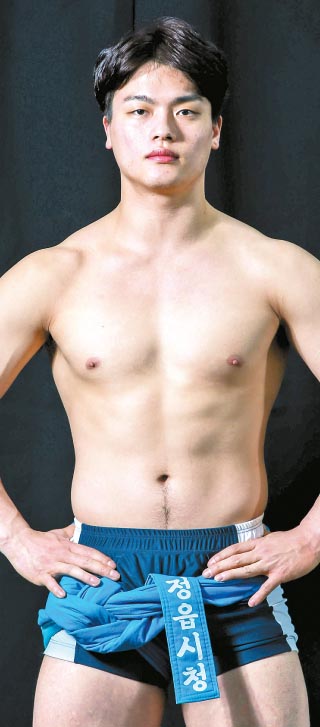Wrestler brings new wow to traditional sport
Published: 31 Jan. 2020, 18:50

Ssireum wrestler Hwang Chan-seob, 23, poses while working out for the 2020 Lunar New Year ssireum (Korean traditional wrestling) tournament in Hongseong County, South Chungcheong. [JANG JEONG-PIL]
Although the video was a clip of the final round of the 15th Haksan National Ssireum Competition held in Gimcheon, North Gyeongsang, in 2018, it garnered more than 2.5 million viewers — a viewership unheard of for a clip of traditional Korean wrestling.
Hwang was the reason people watched — or, to be more precise, his buff physique, which belied the widespread notion that ssireum wrestlers had to be obese or, at the least, overly sturdy. The short clip made a lot of viewers reconsider ssireum, a traditional Korean wrestling sport dismissed as something only older people enjoy watching.
The JoongAng Ilbo sat down with Hwang on Jan. 20 at a training ground in North Jeolla to talk about his newfound fame and his future goals.
“These days, I interview with different media outlets every three or four days,” Hwang said. “Although unexpected popularity is a heavy burden for me, I try to be interviewed as much as I can, as it can be a way to reignite the popularity of ssireum.”
In ssireum, two wrestlers face off against each other on their knees in a sandpit ring measuring approximately 7 meters (30 feet) in diameter.
Holding onto cloth sashes tied around their waists, they use strength and technique to knock the opponent to the ground. There are foot, leg and hip techniques for lifting, throwing, twisting, tackling and tripping.
Amateur ssireum athletes normally compete according to age divisions — elementary school, middle school, high school, and university. In later years, they use weight classes, including the gyeongjang division, or less than 75 kilograms, which isn’t used in professional competition.
Professional ssireum has four weight classes: taebaek (80 kilograms and below), geumgang (80.1 to 90 kilograms), halla (90.1 to 105 kilograms) and baekdu (105.1 kilograms and above). Hwang plays in the taebaek division, which explains why he doesn’t have the bulk of famous ssireum wrestlers of the past.
The heavyweight divisions of baekdu and halla were the most popular in the past, but taebaek and geumgang are considered hotter now.
Most ssireum athletes wrestle for local governments. Currently, a total of 18 local governments in Korea have their own men’s ssireum teams.
Hwang started his professional career with the Yeonsu District Office in Incheon in January 2019 but moved a month ago to the Jeongeup City Government in North Jeolla.
“Hwang is driving ssireum fever in Korea,” Kim Si-young, director of the Jeongeup team said. “Considering his value as a ssireum athlete and his great growth potential, we will support him in all ways.”
Since Hwang was young, he was good at sports including soccer, taekwondo, and kendo, or Japanese fencing.
Hwang was an elementary school student when he first started learning ssireum. His school had a ssireum club at the time, and it had special appeal to the hungry young boy.
“There were a lot of boxes of snacks and ramen in front of the ssireum club,” Hwang said. “The club director told me that I could eat whatever I wanted if I start learning ssireum. I ate ramen with my colleagues whenever we had long and tough trainings. Since there was no hot water, we had to eat ramen with lukewarm water. I can’t forget the taste of the ramen at the time.”
After enrolling in Kyungnam University in South Gyeongsang, where ssireum champion Lee Man-gi graduated, Hwang actually quit the sport in his sophomore year.
“One day, I just felt that ssireum wrestler is not a job that I can earn enough to feed my families,” Hwang said. “At the time, I thought ssireum didn’t have a future.”
He did some part-time jobs and tried to live the life of a normal student. But less than two months later, Hwang came back after pleas from his team manager.
The two-month break became a driving force that helped Hwang concentrate on ssireum. When he became a senior, he was one of the top ssireum athletes after winning seven gold medals in university tournaments.
“If I didn’t have that turning point of my life, I couldn’t have come this far,” Hwang said. “The two months away changed my life.”
The Korea Ssireum Association runs the sport and a total of 19 national competitions are held annually, leading up to a yearly championship held every November.
Hwang made it to the semifinals in national competitions about four times last year. However, he never reached the finals.
“When I was a university student, I played in the gyeongjang division,” Hwang said, “However, I spent lots of time to raise my weight class to taebaek. My goal for this year is to become a champion in the taebaek division. I’m working out so hard to build not only muscle but also strength of mind.”
BY SONG JI-HOON, CHEA SARAH [chea.sarah@joongang.co.kr]










with the Korea JoongAng Daily
To write comments, please log in to one of the accounts.
Standards Board Policy (0/250자)